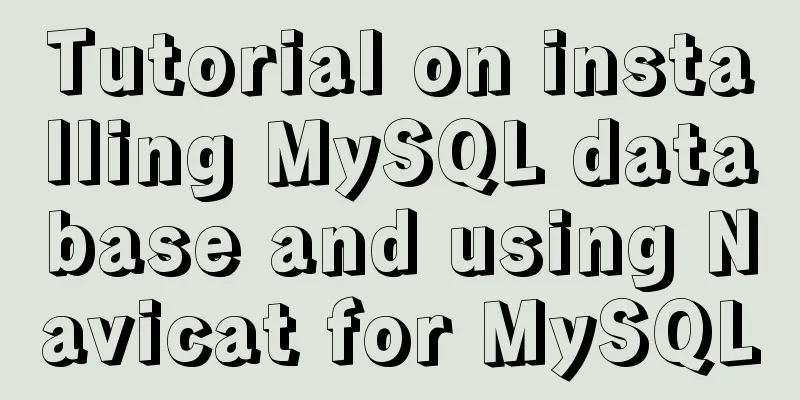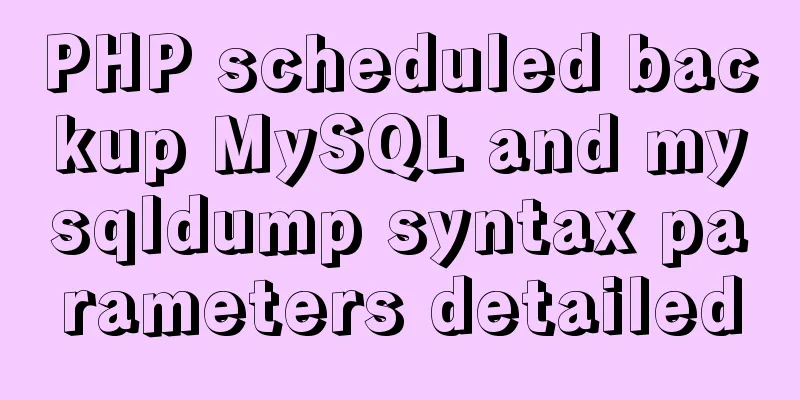Tutorial on installing MySQL database and using Navicat for MySQL

|
MySQL is a relational database management system developed by the Swedish company MySQL AB and currently owned by Oracle. MySQL is the most popular relational database management system. In terms of WEB applications, MySQL is one of the best RDBMS (Relational Database Management System) application software. It has the characteristics of small size, high speed, low cost and open source code. MySQL download address: http://dev.mysql.com/downloads/installer/ Double-click to enter the installation guide interface, click Next, check that you have read the relevant information, and click Next
Then you will enter the type selection interface, where there are 3 types: Typical, Complete, and Custom. Here we recommend choosing "Custom" installation, so that you can customize the MySQL installation directory, and then click "Next" to display the custom installation interface. For the sake of data security, it is not recommended to install MySQL in the C directory of the system disk.
Click Next to start the installation.
After the installation is complete, the MySQL configuration guide interface will appear. Click Next
There is an option to guide the configuration of MySQL (Luanch the MySQL Instance Configuration Wizard). It is recommended to check the option to configure your MySQL immediately.
Click Next to configure MySQL.
You can choose two configuration types: Detailed Configuration and Standard Configuration. Select Detailed Configuration and click Next. Configure MySQL MySQL server type
There are 3 server types to choose from Developer Machine : This option represents a typical personal desktop workstation. Assume that there are multiple desktop applications running on the machine. Configure the MySQL server to use the fewest system resources. Server Machine : This option represents the server. The MySQL server can run along with other applications, such as FTP, email, and web servers. The MySQL server is configured to use an appropriate proportion of system resources. Dedicated MySQL Server Machine : This option represents a server that only runs the MySQL service. Assume that no other applications are running. The MySQL server is configured to use all available system resources. Here I chose Developer Machine, mainly for daily development needs. Next, select the database purpose
Multifunctional Database : If you select this option, you will use both InnoDB and MyISAM storage engines and distribute resources evenly between the two engines. This option is recommended for users who frequently use two storage engines. Transactional Database Only : This option uses both InnoDB and MyISAM storage engines, but assigns most server resources to the InnoDB storage engine. This option is recommended for users who mainly use InnoDB and only occasionally use MyISAM. Non-Transactional Database Only : This option completely disables the InnoDB storage engine and assigns all server resources to the MyISAM storage engine. It is recommended that users who do not use InnoDB select this option. I chose Multifunctional Database. The following is the default location for data storage.
Select the maximum number of connections allowed by MySQL. The first one is a maximum of 20 concurrent connections, the second one is a maximum of 500 concurrent connections, and the last one is custom. You can choose according to your needs
The following is to select the port that the database monitors. The default is 3306. If you change it to another port, you must remember the modified port when you connect to the database in the future. Otherwise, you will not be able to connect to the MySQL database, which is troublesome. No changes will be made here. Use the default port of MySQL: 3306.
Configure the MySQL character set and click Next
Configure MySQL service options to install the MySQL server as a service. Install it as a service, and you can automatically start the MySQL server when the system starts
Configuring MySQL security options
Set and remember the super user password. New root password (enter password) Confirm (confirm password) is recommended. There is a checkbox below to select whether to allow remote machines to connect to your MySQL server as root user. If you have this requirement, please check it.
Click Execute to complete the installation and open a command line window
Enter the password and press Enter
Database Information
Press Enter and you will see the database information. You can operate the database here, including adding, modifying and checking. I will not go into details.
Next, desktop tools can be used to operate the database without writing code. Client tool: Navicat for MySQL Green version download address: http://www.cr173.com/soft/38153.html Official website download address: https://www.navicat.com
After registration is completed, open the interface, click Connect, and enter relevant information.
Connection successful, OK
In this way, you can operate the database manually, import SQL files for execution, or write code. It is very convenient. Summarize The above is the tutorial on MySQL database installation and Navicat for MySQL usage introduced by the editor. I hope it will be helpful to everyone. If you have any questions, please leave me a message and the editor will reply to you in time! You may also be interested in:
|
<<: Vue routing returns the operation method of restoring page status
>>: How to configure Openbox for Linux desktop (recommended)
Recommend
Example of implementing grouping and deduplication in MySQL table join query
Table of contents Business Logic Data table struc...
Detailed process of deploying MySQL with docker (common applications deployed with docker)
I have introduced it to you before: docker (deplo...
About the bug of better-scroll plug-in that cannot slide (solved by plug-in in 2021)
Better-scroll scrolling principle As a parent con...
How to pop up a temporary QQ dialog box to chat online without adding friends
In fact, this is very simple. We add an a tag to ...
How to install MySQL database on Debian 9 system
Preface Seeing the title, everyone should be thin...
CentOS server security configuration strategy
Recently, the server has been frequently cracked ...
Nginx rewrite regular matching rewriting method example
Nginx's rewrite function supports regular mat...
MySQL free installation version configuration tutorial
This article shares the MySQL free installation c...
How to automatically import Vue components on demand
Table of contents Global Registration Partial Reg...
How to use CSS counters to beautify ordered lists of numbers
In web design, it is very important to use an org...
Detailed explanation of eight ways to optimize MySQL database (classic must-read)
introduction: There are a lot of information and ...
mysql5.7 remote access settings
Setting up remote access in mysql5.7 is not like ...
How to write the style of CSS3 Tianzi grid list
In many projects, it is necessary to implement th...
Detailed explanation of the difference between arrow functions and normal functions in JavaScript
This article explains the difference between arro...
Vue+thinkphp5.1+axios to realize file upload
This article shares with you how to use thinkphp5...


































